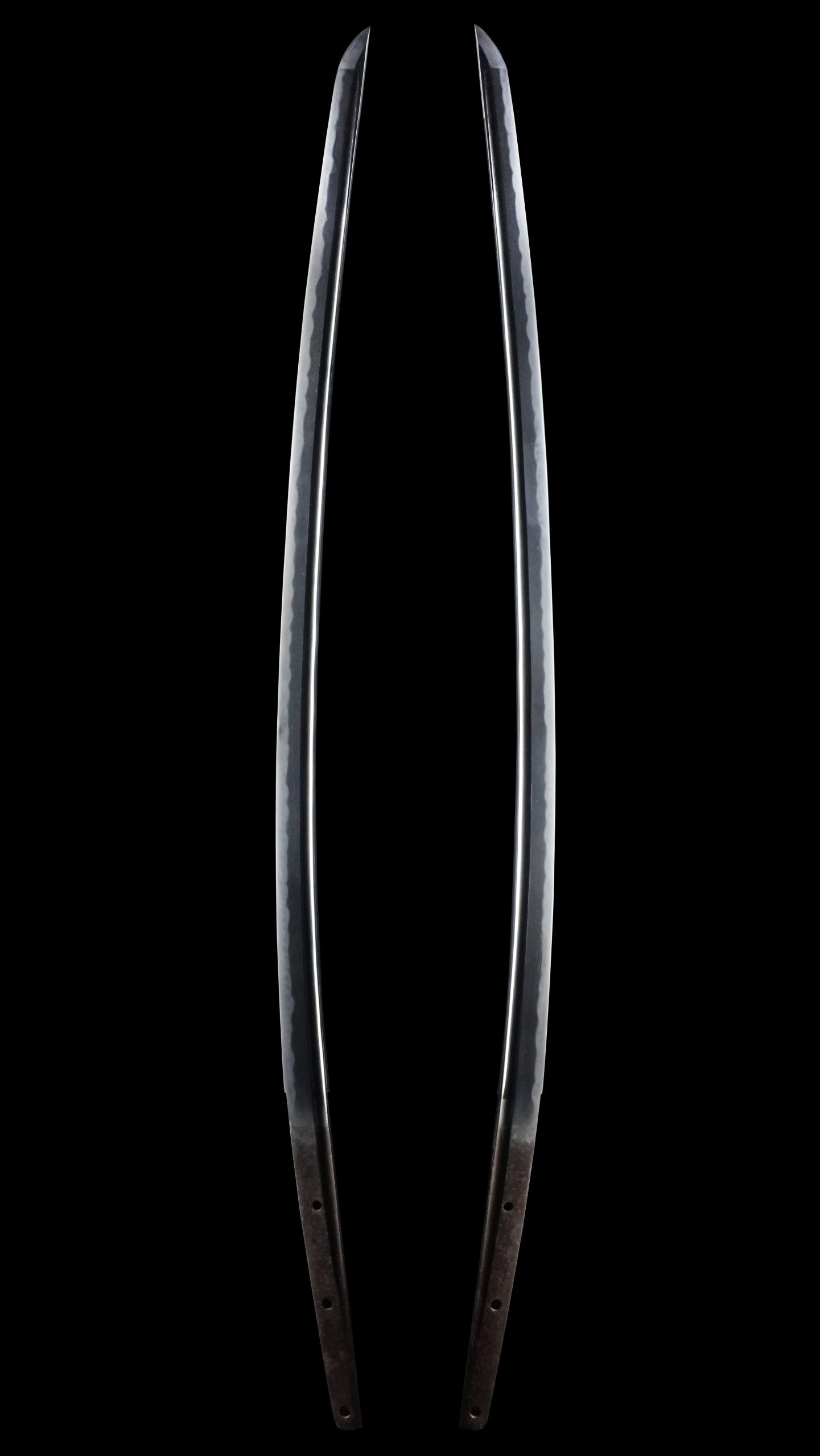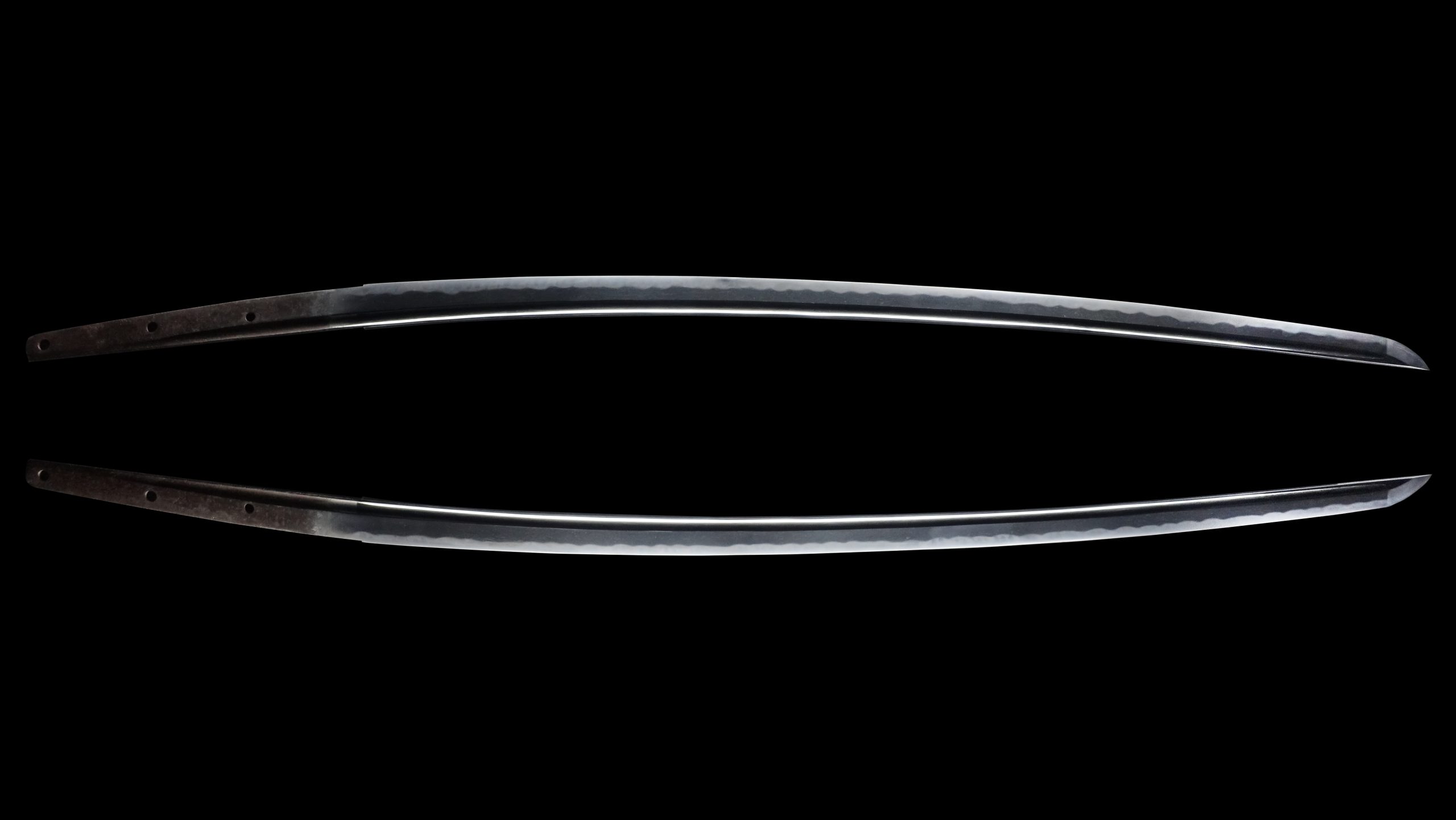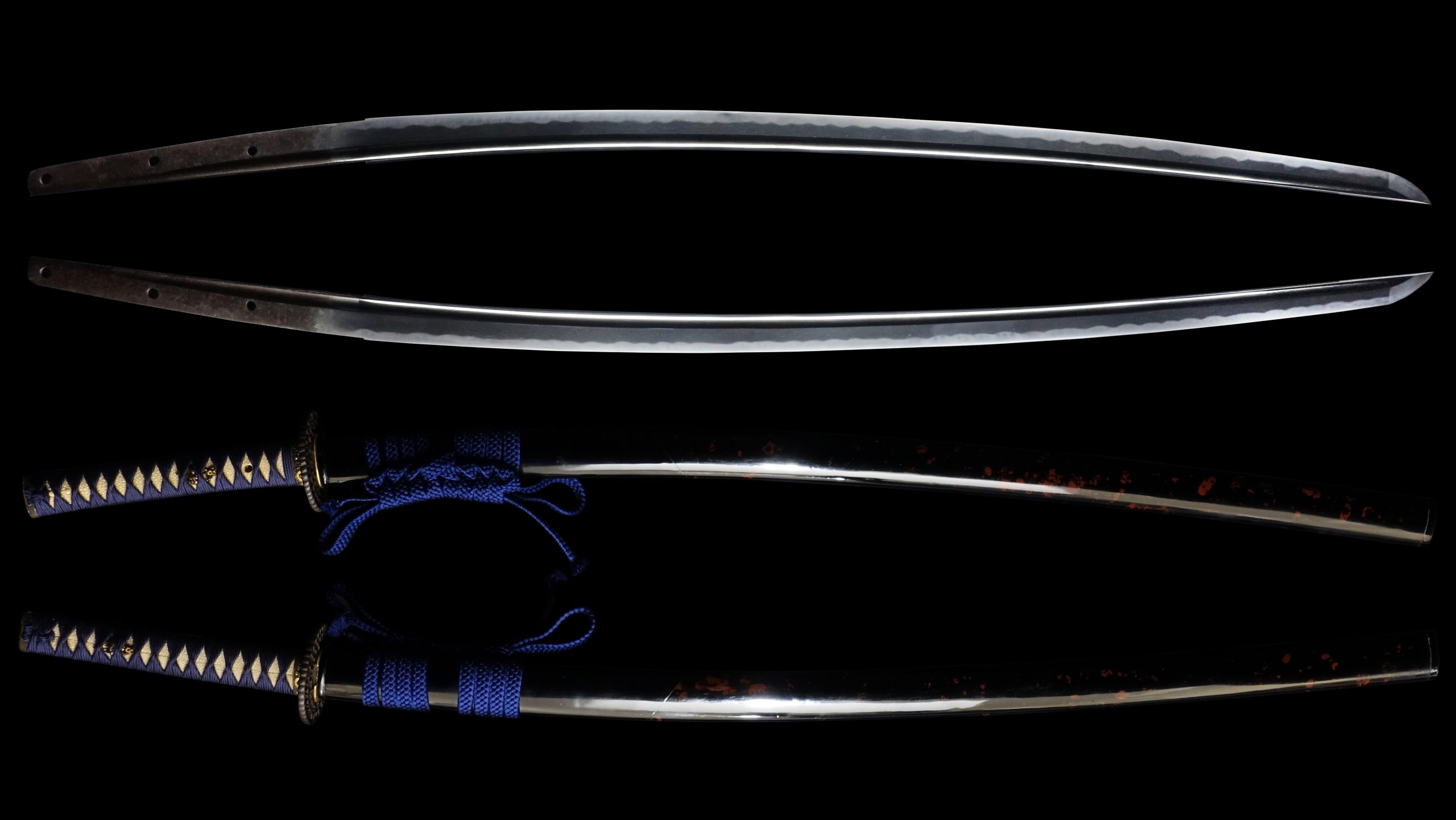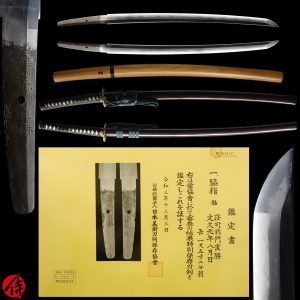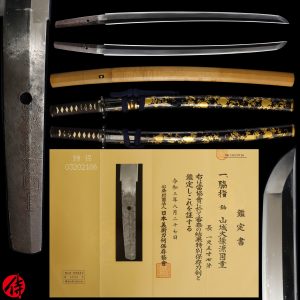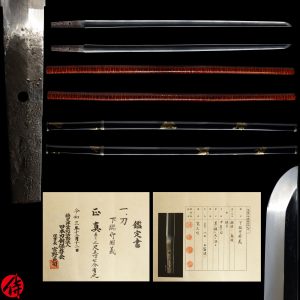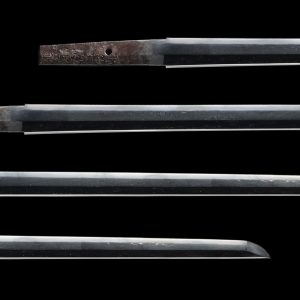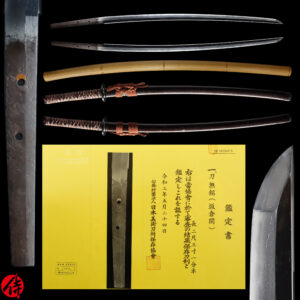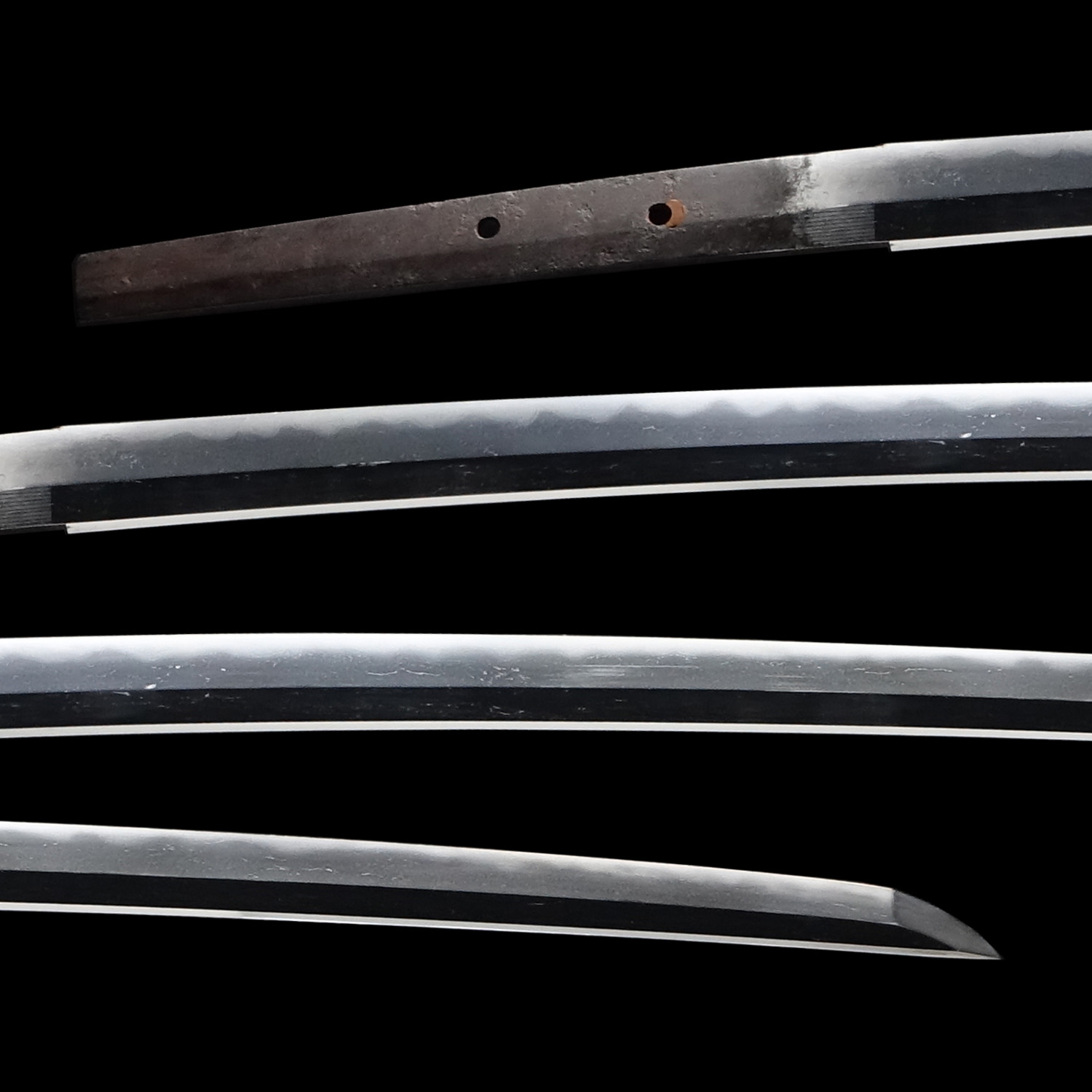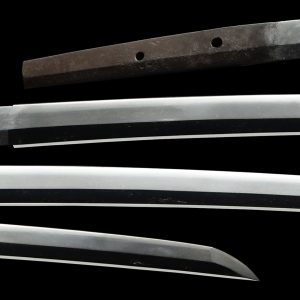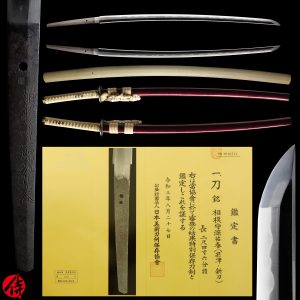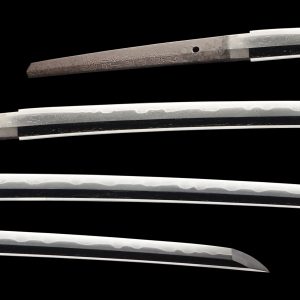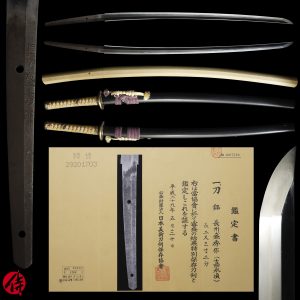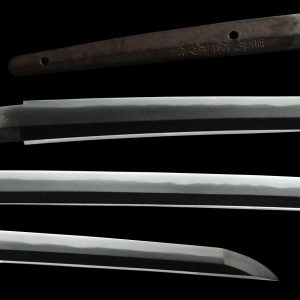Antique Japanese Sword Katana Attributed to Seiryuken Moritoshi with NTHK Kanteisho Certificate
【Description】
According to NTHK’s appraisal, this blade is attributed to Seiryuken Moritoshi (青龍軒盛俊) during the Genji era (1864-1865: The end of the Edo period ). Moritoshi is one of the most renowned swordsmiths in the Choshu domain at the end of the Edo period (Bakumatsu era).
In the second year of the Kyowa (1802), he was born in Iwakuni city, Suo province (Yamaguchi prefecture). His birth name was Iwamoto Kyozaemon. Firstly, he was studying sword-forging techniques in Yamaguchi prefecture but moved to Edo city to become an apprentice of Chounsai Tsunatoshi (長運斎綱俊). Moreover, he also learned from Koyama Munetsugu(固山宗次), an apprentice of Tsunatoshi. Both were very popular in Edo city at the end of the Edo period. One year later, he was allowed to sign Moritoshi as his maker’s name, returning to Iwakuni city. He firstly named himself Seiryushi (a child of Blue Dragon) and then changed it to Seiryuken (A house of Blue Dragon).
According to Chiyozuru Korehide, another student of Tsunatoshi, the son of Tsunatoshi (Koretoshi), was sent to Morihide to be trained under his roof when Korehide was 12 years old. This fact indicates that Moritoshi was trusted by his master very much, and his craftsmanship was highly appreciated. Furthermore, Moritoshi also trained Morihide, the second-gen Moritoshi, and other swordsmiths.
It is said that Moritoshi was very passionate about studying different sword-forging techniques. Nine years after his first apprenticeship, he returned to Edo city to learn from Tsunatoshi. Moreover, he traveled through Kanto, Sanin, Kyushu area to improve his craftsmanship from other swordsmiths. Whenever he heard that there were reputable swordsmiths, he visited there and learned their techniques. He was excellent at forging swords in Bizen Den tradition, which he learned from his master. Eventually, he became an Okakaekaji for the Yoshikawa clan, who ruled Iwakuni city. Yoshikawa clan was under the Mori family’s rule, and they were considered a branch of the Choshu domain.
We assume Moritoshi forged many swords for members or vassals of Mori clans during the end of the Edo period. He died on April 25th in the third year of the Keio era (1867) at 66 years of age. It is said that he kept forging swords right before his death. His apprentice Morihide arranged a tombstone for his master. That indicates that Moritoshi and Morihide had close ties and a good master-apprentice relationship.
【 Blade】
Cutting Edge Length(Nagasa): 68.8 cm( 27.1 inches)
Curvature(Sori): 1.97 cm (0.77 inches)

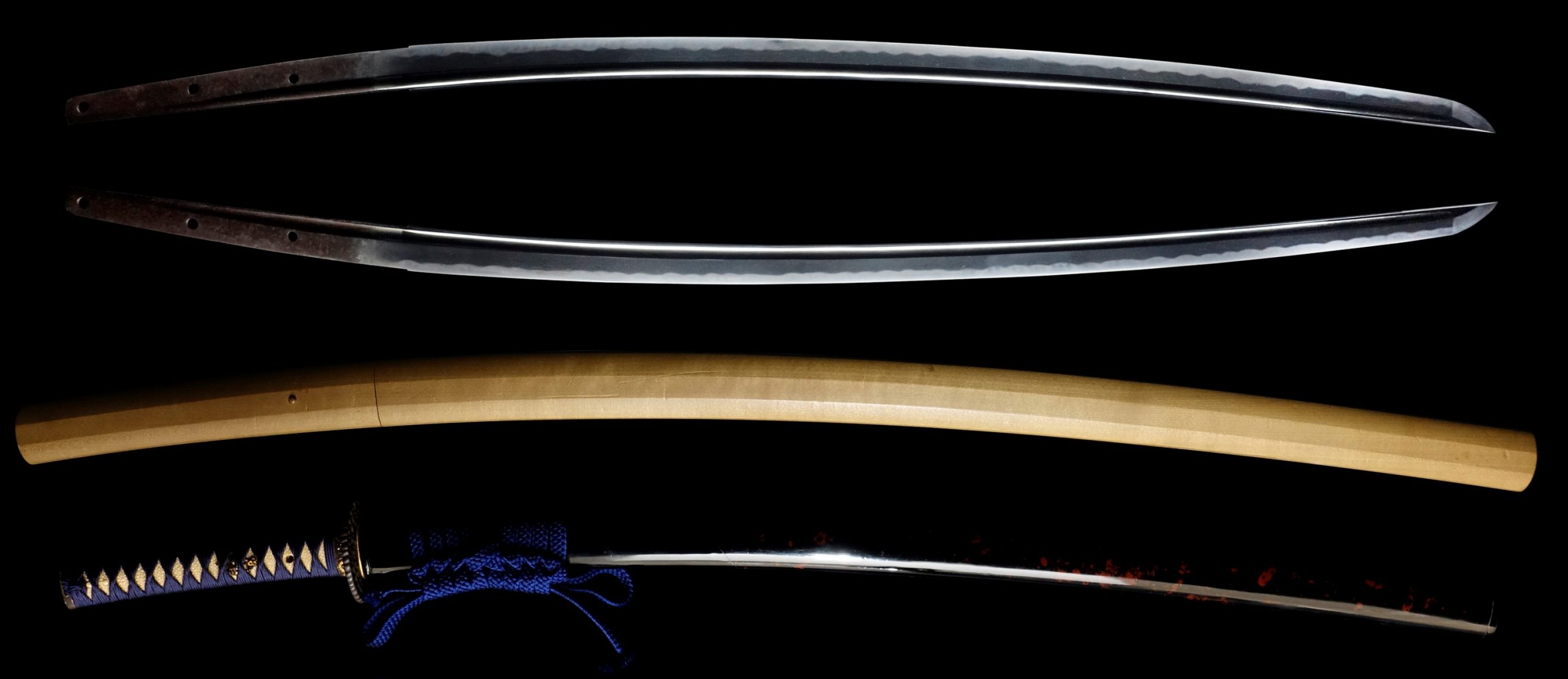
Hamon:
The crystalline structure which forms along the cutting edge of a blade as a result of the hardening process
Jimon(Jihada):
visible steel surface pattern created by folding and hammering during forging process
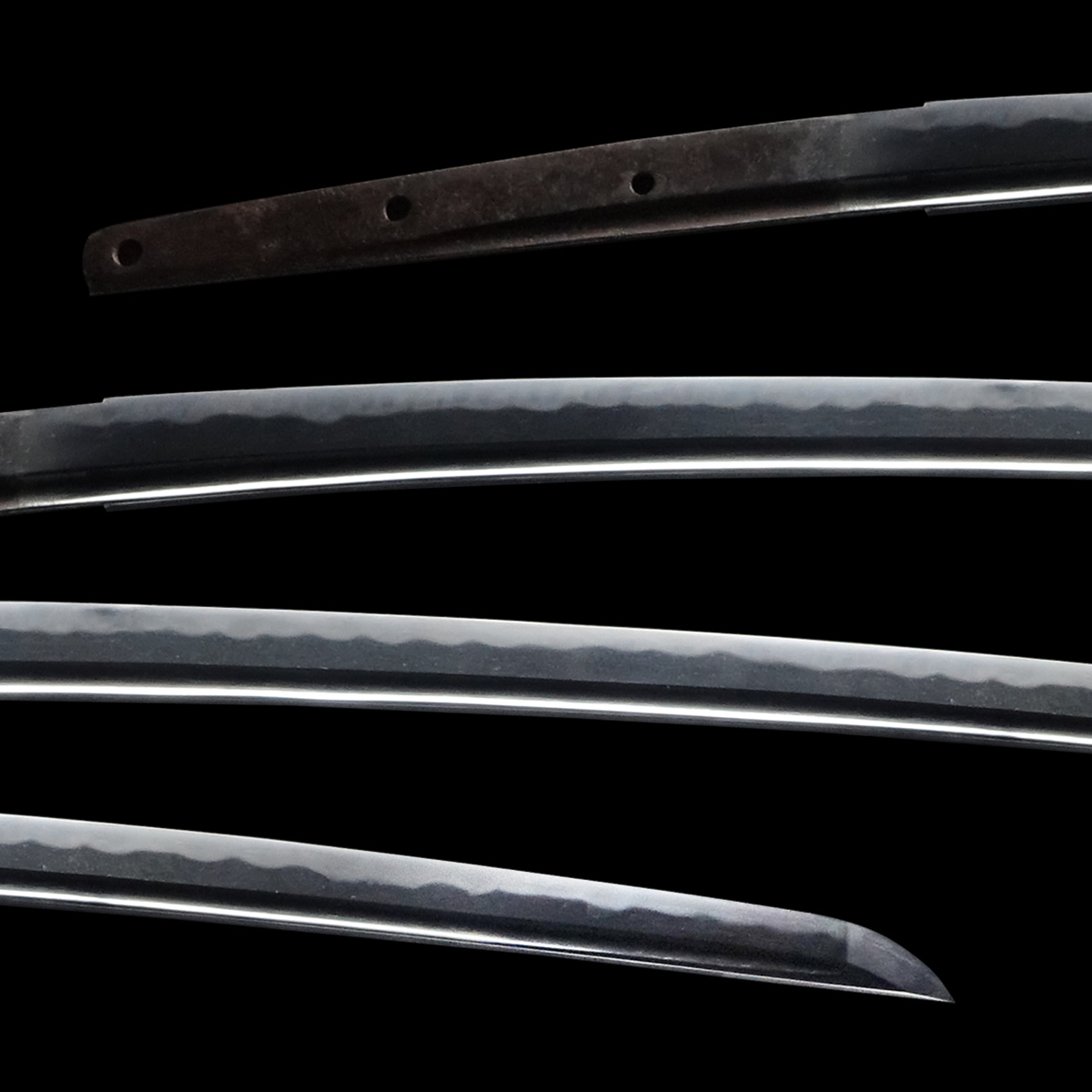
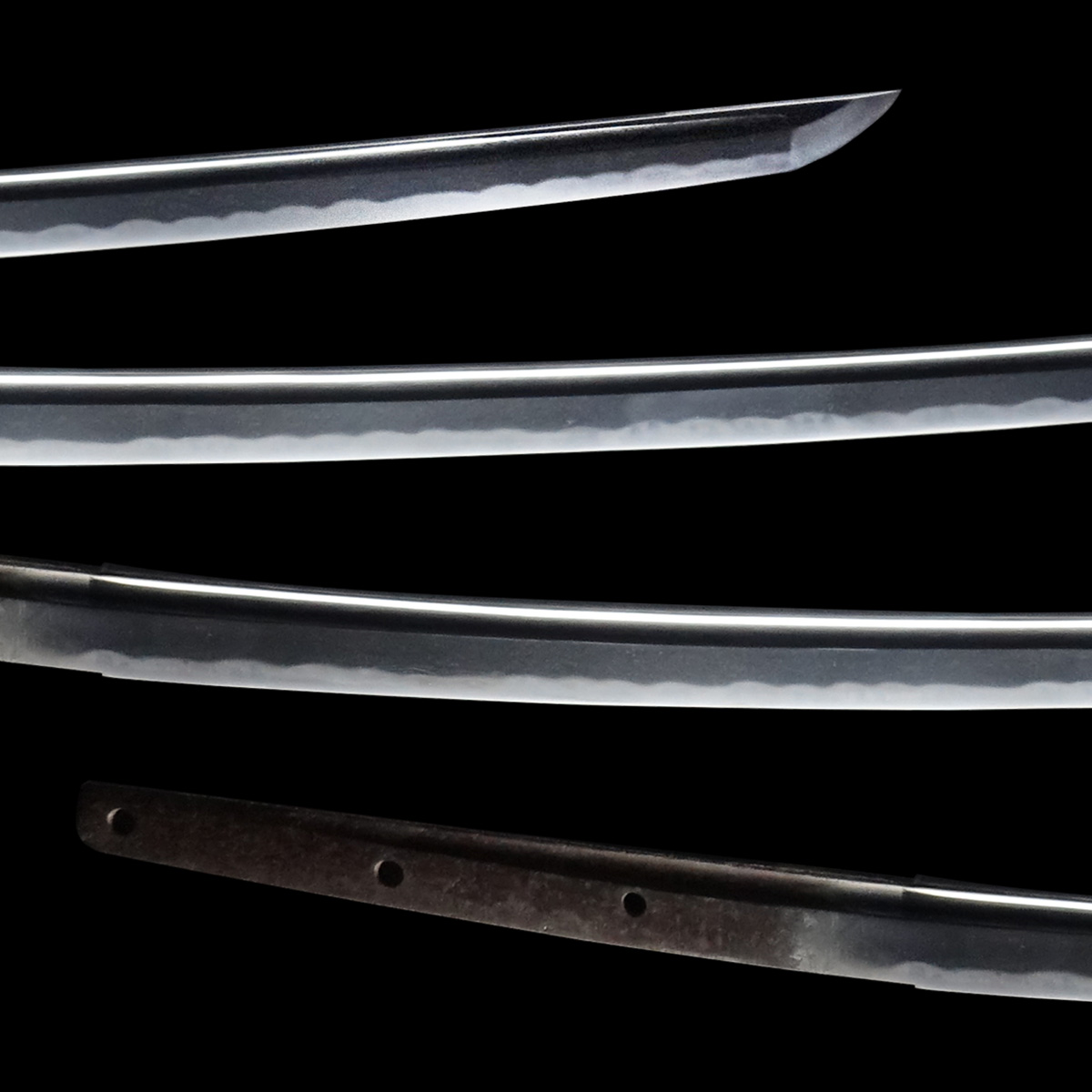
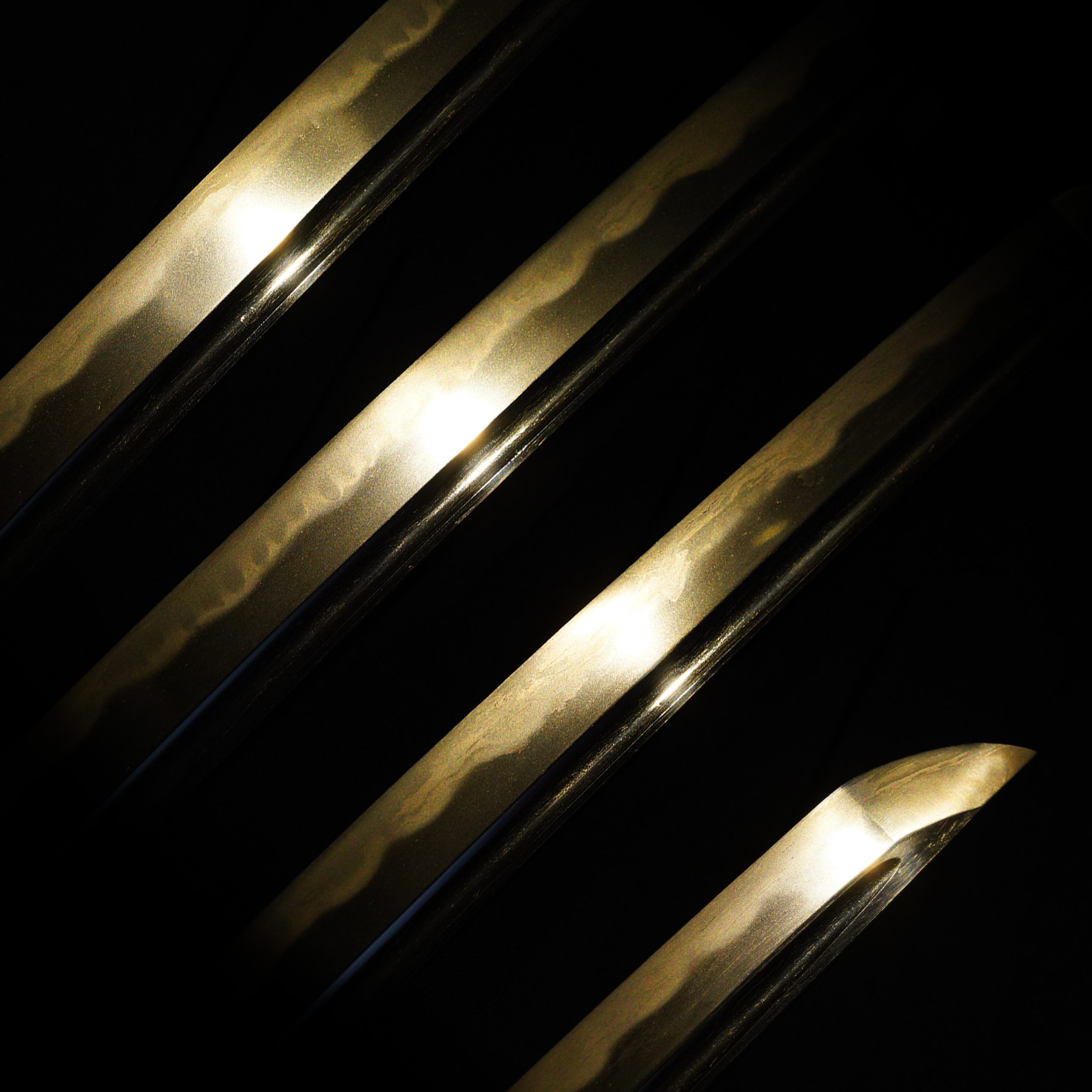

Nakago:Nakago is the tang of the Japanese sword.
Japanese swordsmiths left the black rust on the tang because it prevents red rust while the tang is in its handle. And the discoloration of the tang was created over time, and it is a great indicator for a Japanese sword specialist to estimate when the sword was forged.
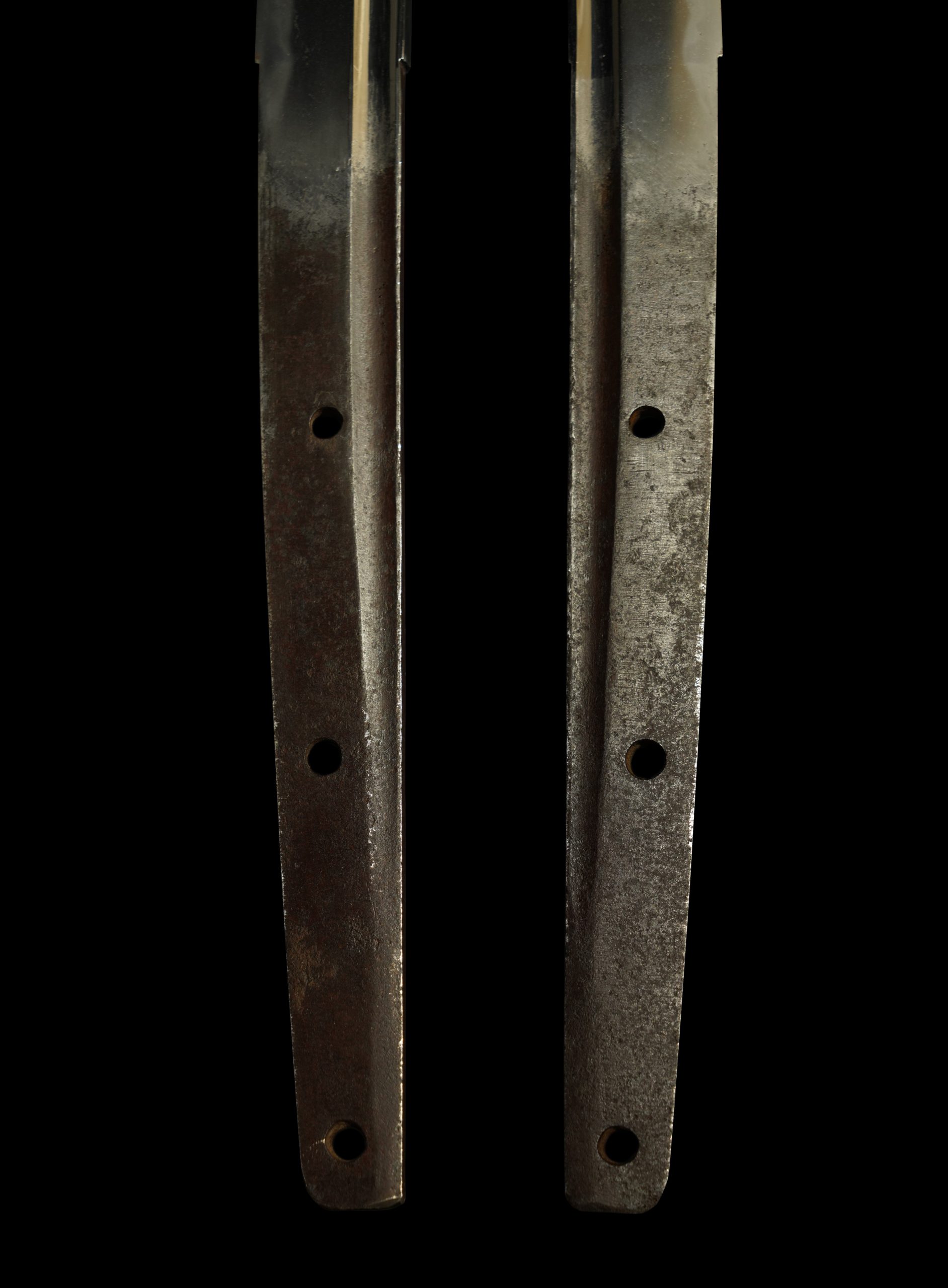
Koshirae: Koshirae is the mounting of the Japanese sword. There are several parts that consist of Koshirae such as Saya(Scabbard), Tsuka( Handle), Tsuba(Handguard).
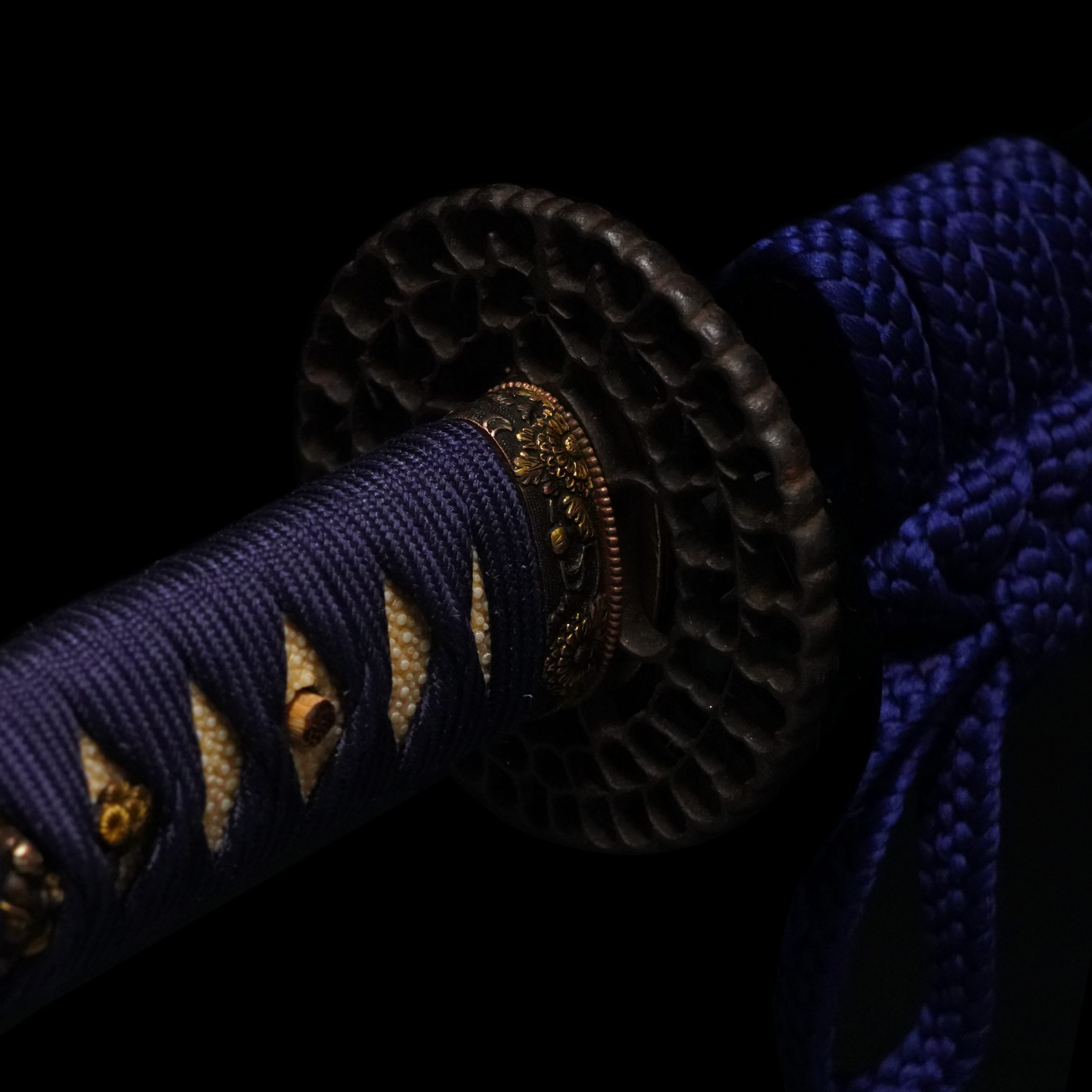
Fuchi-Kashira:A pair of matching sword fittings that cover the upper and bottom parts of its sword hilt.
This Fuchi Kashira has a decorative look thanks to its design. The golden and silvery paints are applied to chrysanthemums and water patterns. We would judge this theme as a type of the Kikusui (菊水) pattern. It depicts chrysanthemum flowers floating in running water. Since a long time ago, the Kikusui pattern has been known as a design that represents longevity based on a legend in the Continent. It says we could extend our lifespan by drinking water flowing from the chrysanthemum colony. Therefore, people treated this design as a kind of good luck motif. It is said this pattern started to be used in the Kamakura period (1185-1333). Some families used it for their family crests. For example, Kusunoki Masashige (楠木 正成, 1294?-1336) is one of them. He contributed to the defeat of the Kamakura Shogunate and was given the chrysanthemum flower crest by Emperor Go-Daigo in recognition of his remarkable achievements. However, Masashige chose to use the Kikusui pattern, the water flowing in the lower half of the chrysanthemum flower. According to a theory, it was because he thought it was too presumptuous to have the same crest as the emperor. This story is just an example, but even it would tell you the deep relationship between the chrysanthemum design and the Samurai culture.
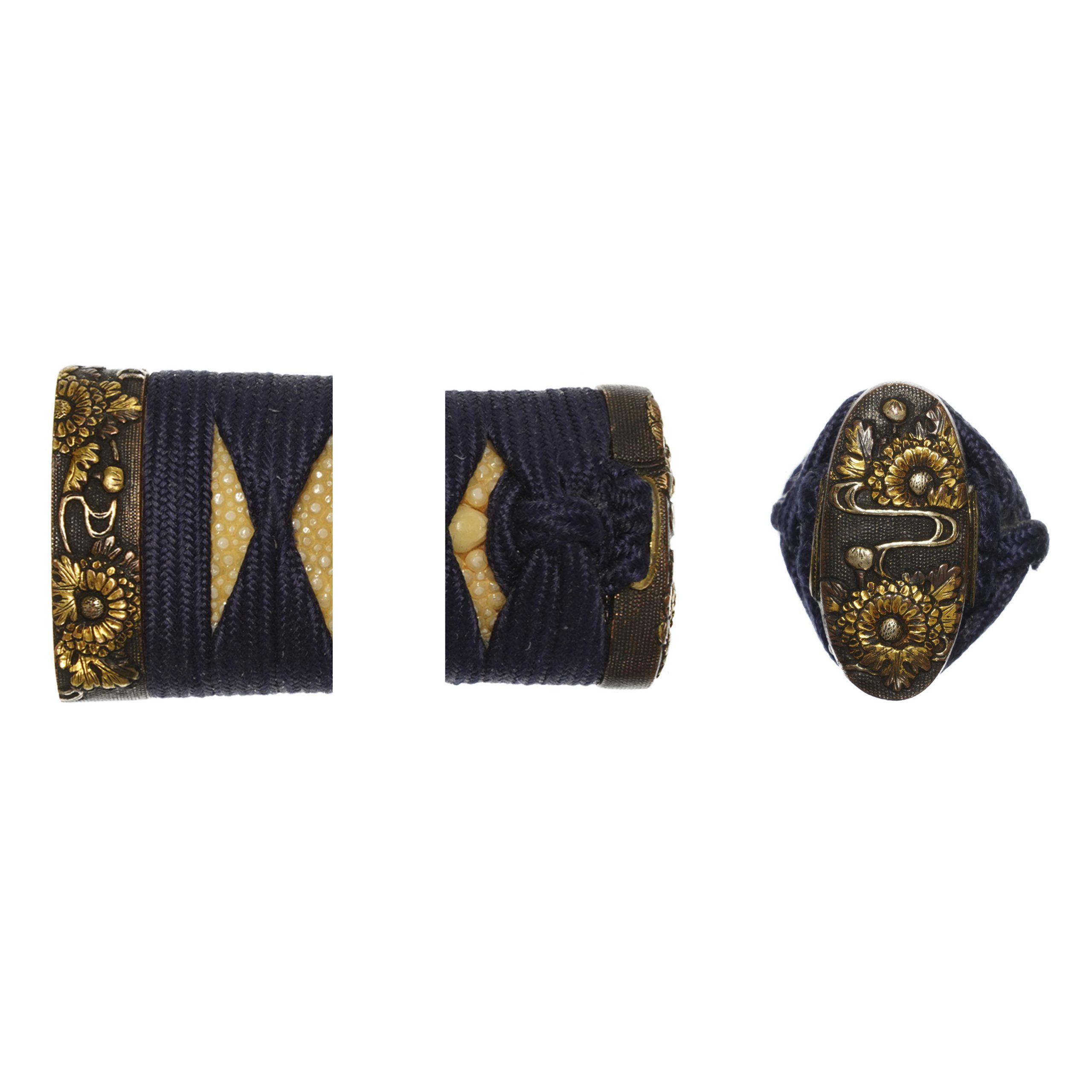
Tsuka and Menuki:Tsuka is the handle of the Japanese sword and Menuki is its decoration.
People (probably an older man and a small child) are designed for this Menuki. It might depict a scenery in daily life. They have gentle expressions and make a calm atmosphere. Same as the Fuchi Kashira, it seems this Menuki is also colored with several metallic paints. This coloring makes an ornamental look for the work.

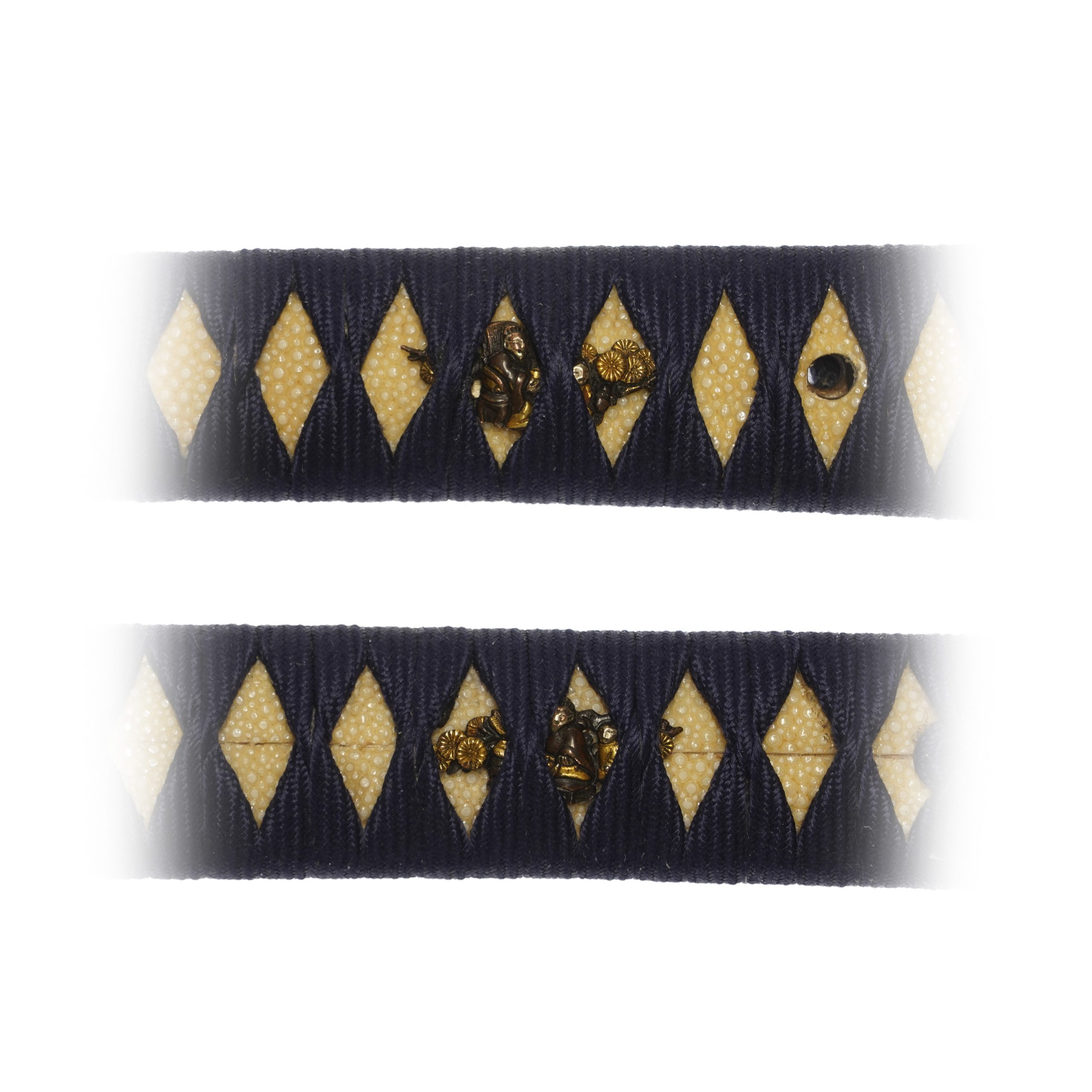
Tsuba and Habaki:Tsuba is the handguard for the Japanese Sword and Habaki is the equipment to make the blade not touch its scabbard inside. It prevents the blade from getting rusty and chipped.
This Tsuba has a symmetry design. We think its shape shows the Sagari-Fuji (下り藤) pattern. As wisterias have strong fertility and grow being entwined with other trees, people regarded this flower as a symbol of longevity and prosperity for future generations. Also, its Japanese name Fuji (藤) is likened to another word Fushi, which is written as “不死,” which means immortality. According to a theory, that is why the Fujiwara (藤原) family, who reached the height of glory in the Heian period (794-1185), used this motif for their family name and family crest.
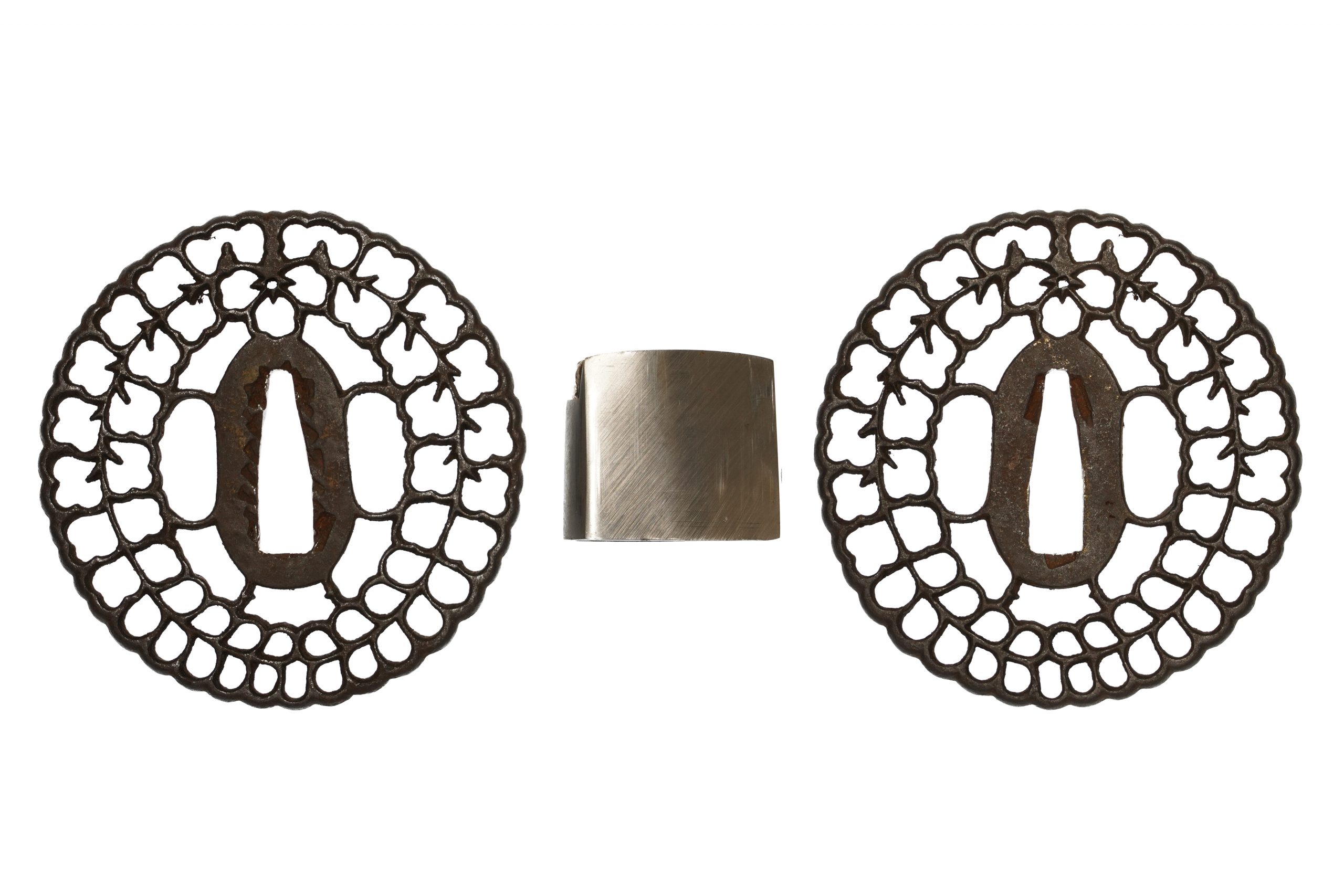
Saya: Saya is the scabbard for the Japanese sword.
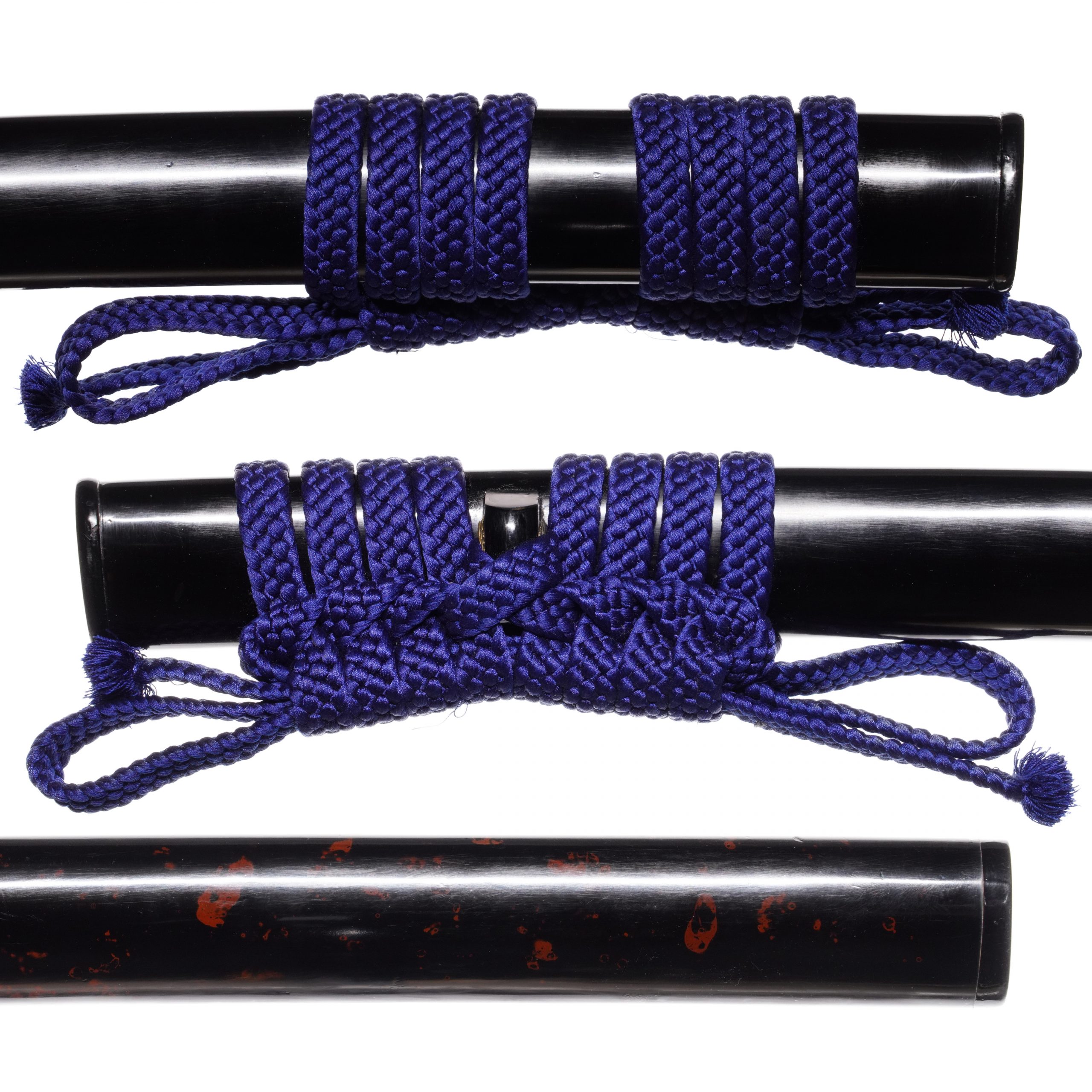
Authentication Paper:NTHK-NPO Kanteisho Certificate for the blade
NTHK, also known as NPO Nihon Touken Hozon Kai, is the oldest organization for sword authentication of Japanese swords in modern times. It was established in 1910 during the post-Samurai era. They authenticated the blade on December 12nd, the 3rd year of Reiwa (2021). The purchaser will receive this original certificate as well. We can also translate what is written into English and make a PDF file for your record if you request.
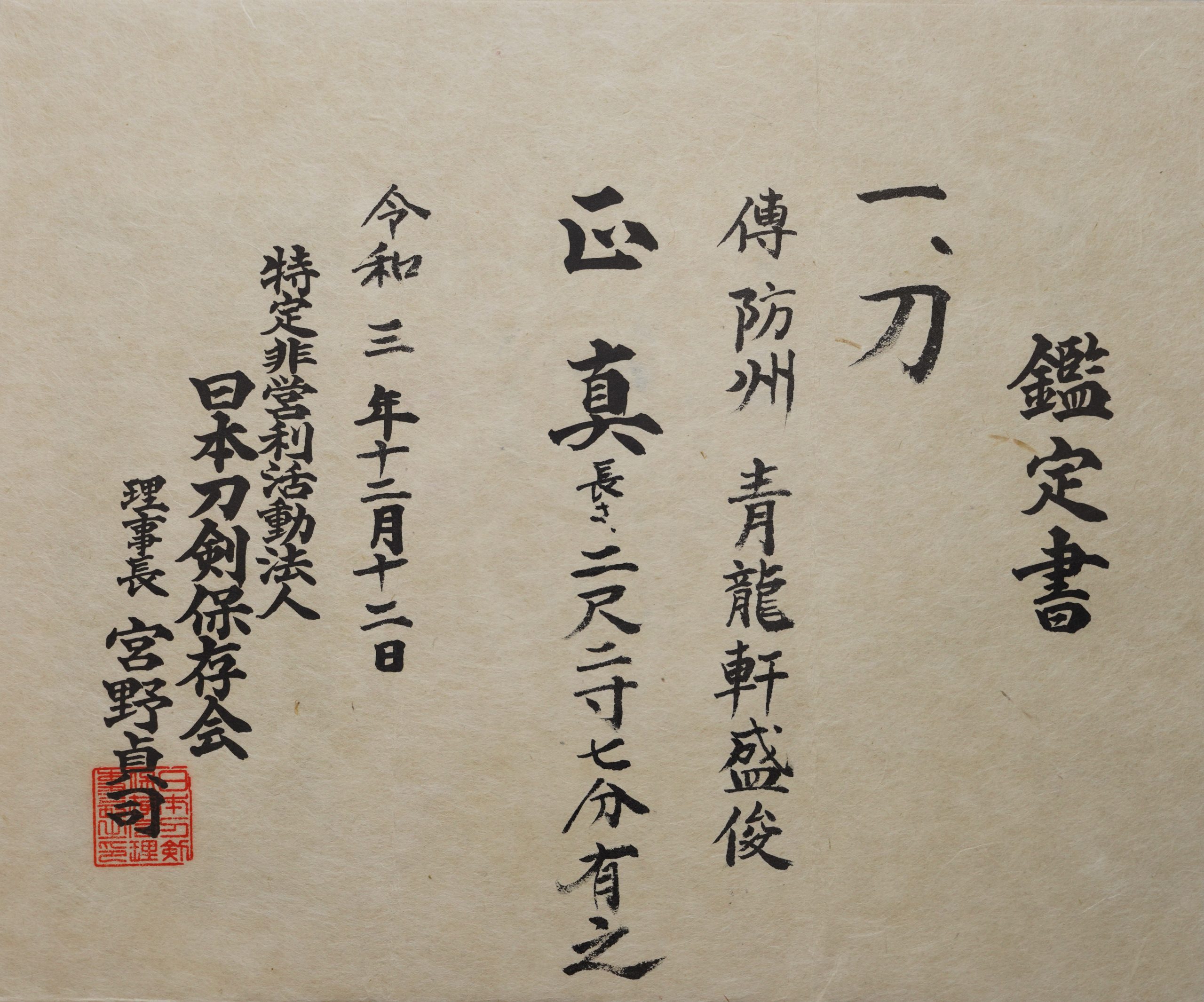
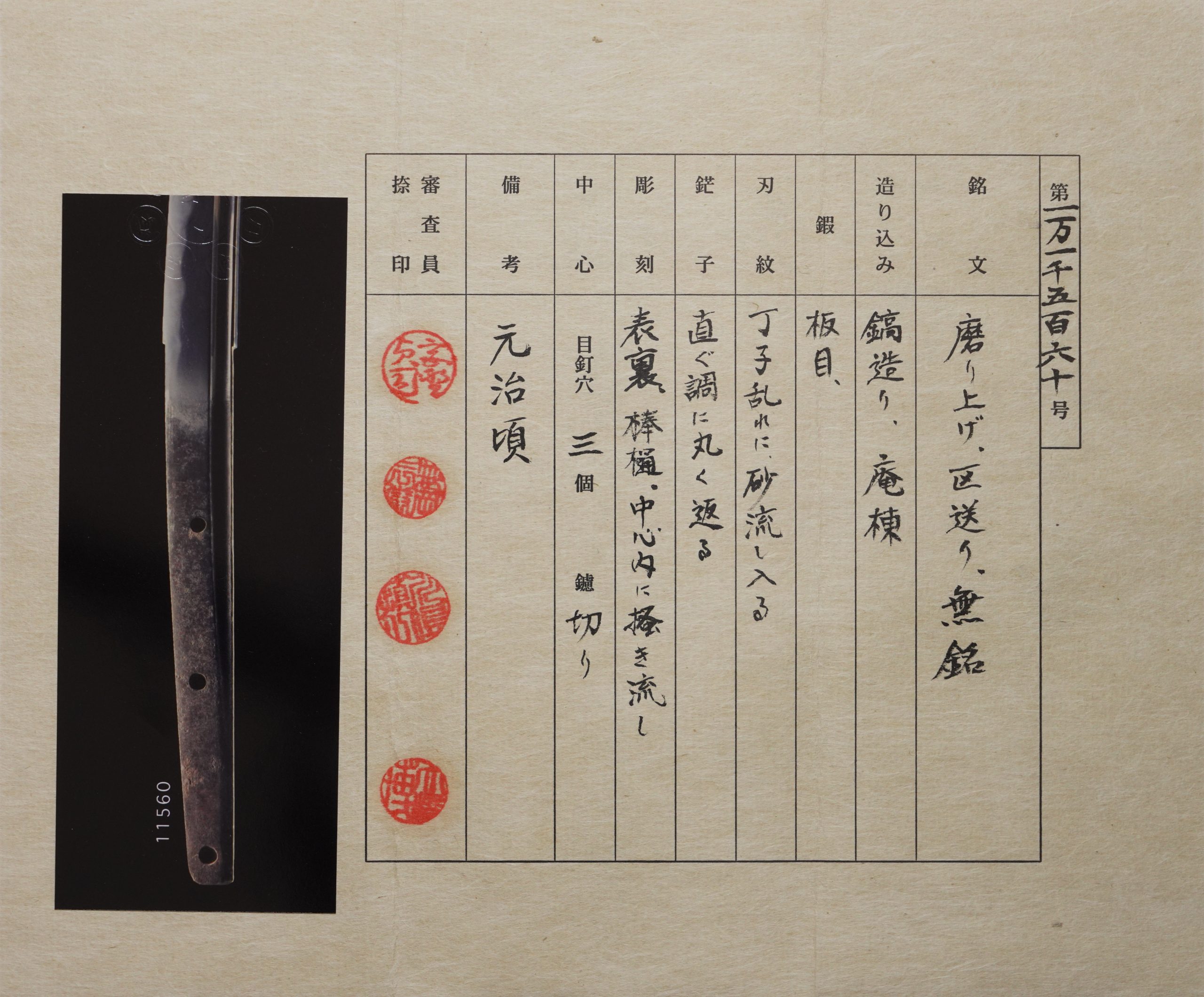
Registration Number : Shizuoka 3380
The Board of Education in Shizuoka prefecture issued a registration paper for this sword . It is called Jyu Token Rui Torokusho(銃刀剣類登録証). Bunkacho(The Agency for Cultural Affairs) acknowledges a Japanese sword with this paper as a work of art.
The sword needs to be traditionally hand-forged and made of Tamahagane carbon steel to be registered in the system. With this paper, its owner in Japan can legally own an authentic Japanese sword. Based on this registration number, we will apply for its export permit.
This paper will need to be returned to the board of education when the sword is being shipped abroad, but you can receive a copy of it. An English translation of this registration paper is available on request.
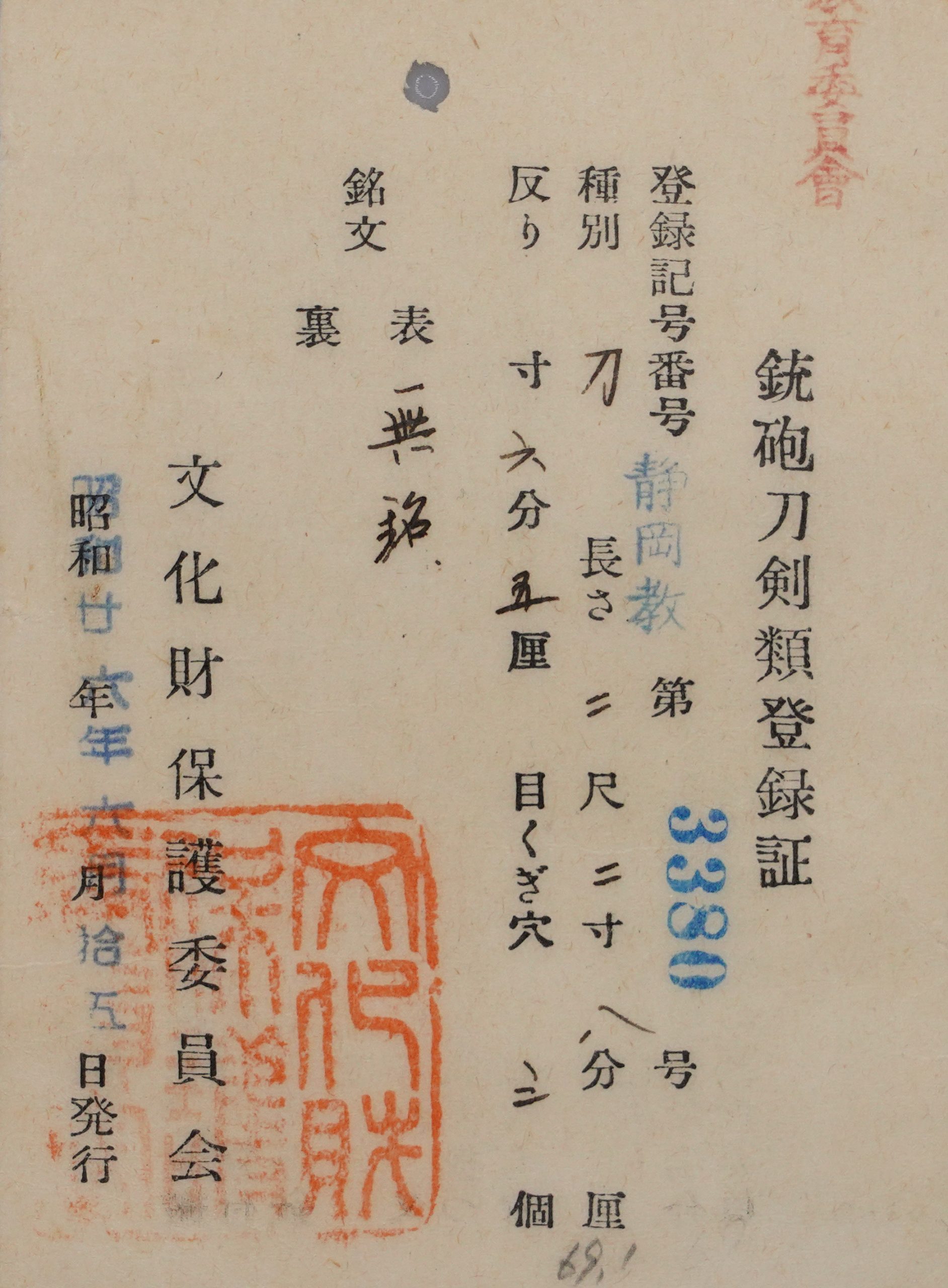
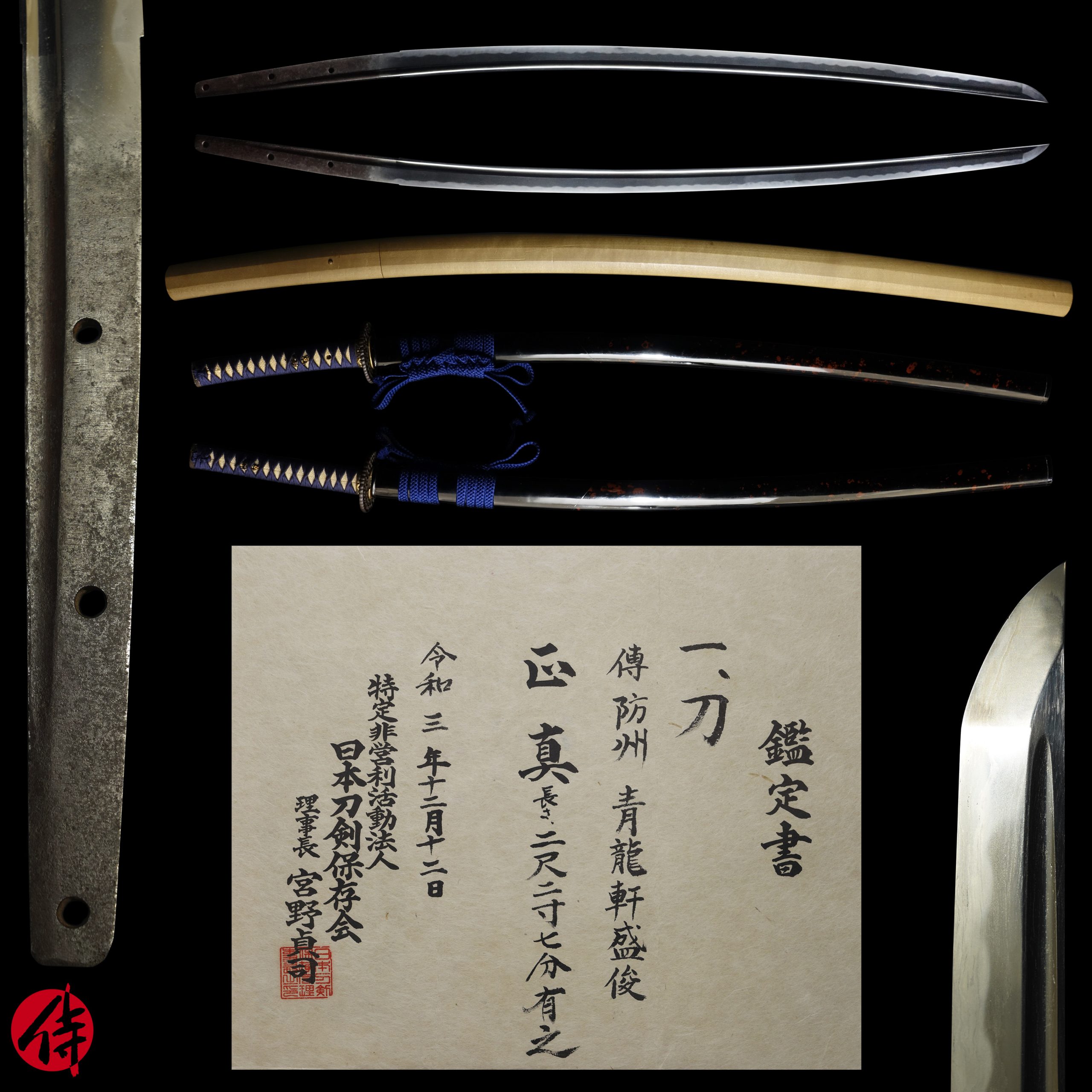
—————————————————————–
【About us】
Samurai Museum is located in Tokyo, Japan, exhibiting antique artifacts related to the Samurai history. Samurai Museum Shop is the place for those who are interested in Japanese culture and craftsmanship. We deal with antique Samurai swords/armor, traditional crafts made in Japan and so on.
【Japanese Sword& Export Process】
The Japanese swords we deal with are hand-forged edged swords made in Japan. It was made from the traditional carbon steel called TAMAHAGANE(玉鋼). Samurai Museum is familiar with the proper legal procedure for an antique/ authentic Japanese sword to be exported from Japan. We have sent more than 400 Japanese swords for the past three years (~2022) to amazing owners who appreciate its historical value.
Each Japanese sword is registered under the Agency for Cultural Affairs and the Board of Education in Japan. They issue a registration paper for each Japanese sword for its owner in Japan to legally possess it. The Japanese sword with its registration paper means it was traditionally hand-forged in Japan.
To legally export the sword from Japan to other countries, we will have to apply for its permit to the Agency for Cultural Affairs(Bunkacho) and return the original registration paper to the Board of Education. It normally takes around 2-4 weeks to receive this permit after submitting required documents. And we would like you to expect at least 1-1.5 months for your order to arrive at your given address after you ordered. For more detailed info, please click here.
It is allowed for residents in Japan to own authentic Japanese swords without a special license as long as they come with registration papers. Please feel free to contact us if you are a resident of Japan, whether temporarily or permanently. We will also assist you when you leave Japan and need to obtain the export permit.
【Payment Method】
We accept payment through Stripe (Credit card), PayPal, Apple Pay or ChromePay, all of which are secure payment methods. Also, you don’t need to make an account on Stripe for the checkout. If you prefer other payment method, please contact us. After confirming your payment, we will apply for an export permit. You may either pay in JPY, USD, AUD, CAD,EUR or GBP. The price is set in Japanese Yen. Prices in other currencies are automatically calculated based on the latest exchange rate.

* If the amount is above 1 million JPY, Stripe or wire transfer will be the only options for payment.
【Shipping】
We have shipped authentic Japanese swords to the USA, UK, Canada, Mexico, Germany, Switzerland, France, Hong Kong and Australia. If you don’t live in these countries and like to order, please contact us first before making a purchase. We offer Free International Shipping as long as we can send antique Japanese swords by either EMS or FedEx(Canada).
We normally ship by EMS(Express Mail Service) provided by Japan Post. When we receive an order from the Canada we will use FedEx instead as EMS temporarily stops shipping from Japan to those countries due to COVID-19.
We will send you a tracking number for your order as soon as we hand it to the post office/FedEx. We will put 100 % insurance on the shipping document without any extra charge. Based on the total amount, there might be a duty tax or other fee for you to pay, depending on the countries. We use package cushioning to protect the item and put it in a PVC pipe, which is one of the most secure packages because of its durability.
It will normally takes 5-14 days for the item to arrive at your given address after we dispatch it. Time of delivery is estimated as accurately as possible by the carrier but does not take into account any delays beyond our control such as by inclement weather, post office holiday seasons.
* If you live in Australia and like to purchase an authentic Japanese sword, please click here to know the detail.
*Please keep in mind that due to the spread of COVID-19, there might be delays in shipping. If you like to know the detail about shipping, please feel free to ask us.

【How to make sure the condition】
Please keep in mind that what you are going to purchase is an antique item. We uploaded high resolution photos for you to check its condition thoroughly. If you like to see more photos with different angles, please feel free to contact us. We will be happy to send them to you so that you can make informed decision. It is essential for us to know that you are happy with your choice of a sword. and we are prepared to use the best of our ability to serve you.
【How To Contact Us】
Please contact us through email, Facebook Messenger or Live Chat if you have any questions. You can find each icon on the right side of the website. Please click one of them to reach us. We will reply to you within 1-2 business days.
【The Art of Nihonto(Japanese Sword)】
Samurai’s history is a profound, eloquent legacy of ancient Japanese warriors in which millions of people worldwide are being fascinated. If you like to find out the art of Nihonto, please click here.
【A Guide to Japanese Sword Maintenance】
After acquiring an genuine Japanese sword, it is also important to know how to take good care of it. Here is the special video for you. Mr. Paul Martin, Japanese sword expert, shows you how to give proper maintenance to your sword. By mastering how to clean the Japanese sword, its aesthetic beauty will last forever.
When you purchase a Japanese sword from us, you can get a Free Japanese sword maintenance kit. It comes with four tools(Choji Oil, Uchiko Whetstone Powder, Peg remover, Oil Applicator). By watching the video instruction above , you can enjoy learning how to maintain your Japanese sword while appreciating it. If you have any difficulty assembling the sword or cleaning the blade, you can feel free to contact us.


MORE ANTIQUE JAPANESE SWORD FOR SALE
LEARN JAPANESE SWORD TERMINOLOGY
Thank you for reading all the information on the page. If you have any difficulty choosing the right Japanese sword for you, we will be more than happy to help you find the one that speaks to you the most. Please feel free to contact us.
